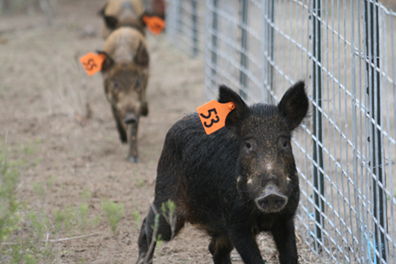The increased feral hog elimination efforts by the Missouri Feral Hog Elimination Partnership (the Partnership) underway on public and private land in southeast and south-central Missouri is the latest chapter in Missouri’s long fight to defend the state against the nuisance animals. Ongoing winter operations mirror the adapted philosophy that’s also taking place elsewhere in the U.S. as an increasing number of states realize hunting is an inefficient method of eliminating a creature neither farmers nor recreational enthusiasts want on the landscape.
The Partnership is made up of several organizations, but active on the ground efforts involve staff from Missouri Department of Conservation (MDC), U.S. Forest Service (USFS), USDA APHIS Wildlife Services and the L-A-D Foundation.
In Missouri, hard-working farmers and responsible landowners have a long history of hating feral hogs. One of the state’s early livestock fencing laws, a St. Charles County law enacted in 1884, was a requirement for the confinement of hogs. It’s significant to note this county law didn’t apply to all livestock – just hogs. It’s a clear indication that more than 130 years ago, Missourians were already trying to come up with solutions for the damage free-range hogs were doing to crop fields, pastures and wildlife habitats across the state.
The free-ranging of hogs in Missouri – and other livestock as well – came to an end with the passage of statewide fencing laws in 1969. Considering the lifespan of feral swine is 10-15 years and the hog elimination efforts that have taken place since then (more than 35,000 hogs have been removed in the last five years alone), it’s clear there’s little to no lineage from the feral hogs being trapped this winter to the free-range hogs that once roamed Missouri’s fields and forests before they were required to be fenced in.
“The feral hogs running free in the state today are the products of human-instigated illegal releases of feral swine into the wild,” said Jason Jensen, who represents MDC in the Partnership. “These unlawful actions were committed by people who sought the recreational value of feral hog hunting opportunities.”
Evidence of illegal movement of feral swine is multifaceted. First, anecdotally, when feral hogs are trapped, technicians often note signs on the hogs showing they’ve been in someone’s possession, such as castrated boars and adult swine with their ears cut off, or sometimes notched. In some cases, they’ve even been tagged or collared. Additionally, feral swine movement has been proven, using genetics.
With support from the USDA’s National Feral Swine Damage Management Program, Wildlife Services’ Feral Swine Genetic Archive team completed genetic analyses of more than 11,500 feral swine samples collected throughout the United States, with approximately 650 samples analyzed from Missouri, explained Dr. Tim Smyser, a research biologist working in wildlife genetics at the National Wildlife Research Center in Fort Collins, Co.
“Using cutting-edge genetic tools, similar to those used by popular human ancestry companies, we are able to describe unique genetic signatures for feral swine populations throughout the United States. Further, these tools allow us to map the movement of pigs between populations and a history of that movement from previous generations,” he said. “When we evaluate our large genetic sample of feral swine for Missouri, nearly one out of every six feral swine appear to have been moved in their lifetime. Much of this movement is among populations within Missouri; however, we are also detecting the presence of pigs from out-of-state.”
Smyser added, some feral swine populations in Missouri were identified as introduction hot spots, meaning they are made up of feral swine that have been moved from populations elsewhere within the state.
“These populations show how the illegal movement of feral swine by people influences the spread of feral swine and their damage to agriculture and timber resources,” he said.
Jensen believes the terms ‘feral hogs’ and ‘hunting’ shouldn’t be linked, because hunting is an activity that involves a limited harvest so the overall population can be sustained for future recreational activity.
“This doesn’t apply to feral hogs,” Jensen said. “The majority of Missourians simply want these non-native pests gone and the more effective ways that can be used to accomplish this, the better, and there is nothing ‘sporting’ about releasing an animal as invasive and detrimental as feral hogs.”
The reasons Missourians hate feral hogs are the same reasons releasing them into the wild is illegal. The rooting and wallowing of feral swine can destroy acres of pastures, hayfields and crops. They also damage orchards, raid livestock feeders and foul water supplies.
The Missouri Department of Agriculture (MDA) plays an active role every day in livestock disease control and prevention. Livestock producers who raise cattle and swine work year-round to protect their herds from these diseases and this is why MDA is committed to working with the Feral Hog Elimination Task Force on the shared goal of feral hog elimination. As part of that underlying mission, MDA and MDC communicate closely with USDA Wildlife Services as they test feral hog populations for disease. In recent years, USDA annually sampled 100 feral hogs from Missouri and has found feral hogs with diseases like brucellosis, trichinella, pseudorabies, PRRS, and leptospirosis.
Missouri isn’t the only state moving to a trapping-instead-of-hunting strategy to eliminate feral hogs. Other states have found hunting to be an ineffective tool in eradicating feral hog populations. In Kentucky, “The inability of recreational hunting to control or suppress population growth among wild pigs” led Kentucky to use an adaptive science-based approach that includes trapping, aerial gunning, and selective shooting. 2015 Annual State Summary Report – Wild Hog Working Group.
In Arkansas, “Sport hunting of feral hogs has been more a hindrance than benefit.” Arkansas Game and Fish Commission. In Tennessee, “In 1999, TWRA (Tennessee Wildlife Resources Agency) made an attempt to control the expansion of the wild hog population by opening a statewide wild hog season with no bag limit. Unfortunately, it was during this period of unlimited hunting that the wild hog population expanded the most.” TWRA
And in Missouri, human movement of feral swine completely undermines the elimination efforts being undertaken by the Missouri Feral Hog Partnership, according to Travis Guerrant with USDA APHIS Wildlife Services.
“We are systematically working across the landscape eliminating feral swine from watersheds and moving our assets (staff) into new areas where feral swine exist,” he said. “If we have people re-introducing feral swine into areas where populations have been eliminated, or where we are on the verge of elimination, we cannot move our technicians away from that area and it causes delays in our effort towards elimination.”
Guerrant urges the public to report observations or suspicions of the release of feral swine.
“Please report it,” he said. “Multiple agencies are investing significant resources in eliminating feral swine for the benefit of all Missourians.”
Farmers and landowners are reminded that all feral hog sightings, reports of illegal releases of feral hogs, and any type of tampering with trapping efforts can be reported to mdc.mo.gov/feralhog or by calling 573-522-4115, ext. 3296. Illegal feral hog activities can also be reported to MDC’s Operation Game Thief Hotline, 1-800-392-1111. All information is kept in strict confidence.






